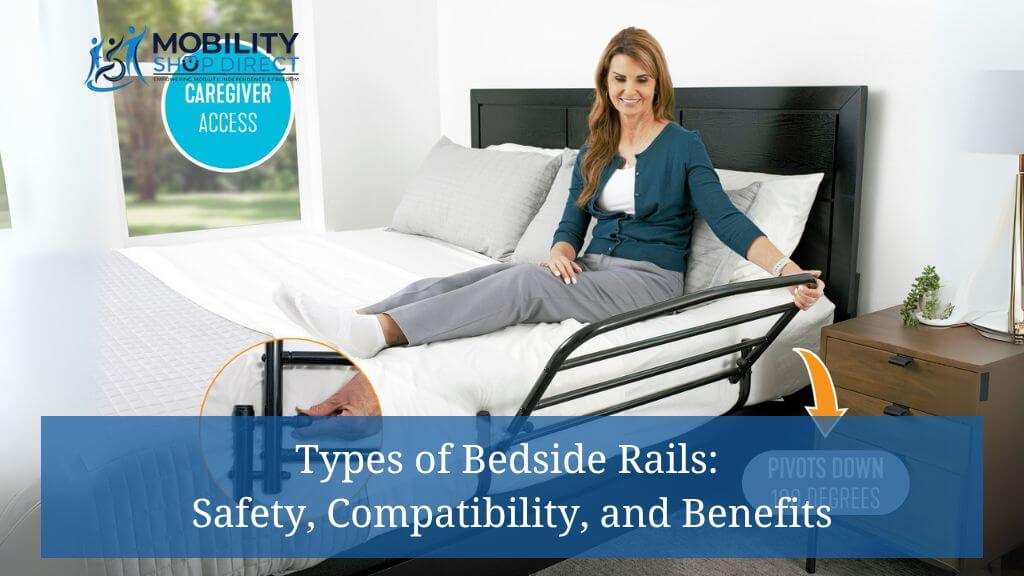Have you ever considered how something as simple as a bedside rail could significantly improve safety and mobility in the bedroom? For seniors, people recovering from surgery, or those with limited mobility, a well-chosen bedside rail isn’t just helpful, it can be a real lifeline. It reduces the risk of falls and offers steady support. But with so many options out there, choosing the right one can get confusing. Which type suits your needs? And how do you make sure it’s safe and compatible with your bed?
This guide breaks it all down. You’ll learn about the different types of bedside rails, what they’re best for, and which safety features to look out for. We’ll also go over how to make sure the rail fits your bed and how to install it the right way. Let’s get into it.
Table of Contents
- What Are Bedside Rails and Why Are They Important?
- Types of Bedside Rails Explained
- Key Safety Features to Look For in Bedside Rails
- Bed Compatibility: Can Any Bed Rail Be Fitted to Any Bed?
- How to Install Bedside Rails: Practical Considerations
- Key Takeaways
- Conclusion
What Are Bedside Rails and Why Are They Important?
Definition and Purpose of Bedside Rails
A bedside rail is a support bar that attaches to the side of your bed. It’s there to help you move more safely, whether that’s sitting up, shifting position, or getting in and out of bed. For many people, it can be the difference between independence and needing constant help.
Bedside rails help in three big ways: preventing falls, supporting mobility, and helping people stay independent. If you’re recovering from surgery or have limited mobility, the right rail can make daily routines a lot safer and less stressful.
How Bedside Rails Enhance Safety and Mobility
Falls are a serious concern, especially for older adults. Bedside rails act like a safety net by creating a barrier and giving you something solid to grab onto. They also help people shift positions or sit up more easily, which reduces strain and helps avoid injury.
Take someone recovering from hip surgery, for example. Instead of relying on a caregiver every time they move, they can use the rail to support themselves. That’s a boost in both safety and confidence. And if you’re a caregiver, having a rail in place gives peace of mind.
Let’s take a look at the types of rails you can choose from.
Types of Bedside Rails Explained
Full-Length vs. Half-Length Bedside Rails
Full-length rails run along most of the bed’s side. They’re great for people who toss and turn or are at high risk of falling out of bed. The trade-off? They can feel a bit limiting and might make it harder to get in and out without help.
Half-length rails are shorter and give you support right where you need it, like when you’re sitting up or getting out of bed. They leave more open space, so they feel less confining.
Your choice depends on how much support is needed and whether ease of access is a priority.
Portable and Adjustable Bed Rails
Portable rails are lightweight and easy to move. They’re good for travel or if you need a temporary solution after surgery. You just slide them under the mattress, and they’re ready to go.
Adjustable rails let you change the height or length to suit different needs. This is helpful if mobility issues change over time or if you’re sharing the rail between beds.
If you want a flexible option that adapts over time, these styles are worth a look. You can learn more in this guide on adjustable rails.
Hospital Bed Rails vs. Home Bed Rails
Hospital rails are built for medical beds. They often have more secure locking systems and are designed to hold up under regular movement and adjustments. But they can be bulky and harder to install.
Home-use rails are simpler and designed to fit most regular beds. If you’re not dealing with a complex medical condition, they’ll usually do the job just fine. For a breakdown of compatibility and types, check out this article.
Key Safety Features to Look For in Bedside Rails
Bed Rail Safety Standards and Certifications
If safety’s your top concern, look for bedside rails that meet recognised safety standards. In Australia, that could include products listed with the Therapeutic Goods Administration (TGA) or those tested to meet ISO or AS/NZS standards for medical equipment. These certifications help ensure the rail has been assessed for durability and reliability—especially important for older adults or anyone with mobility or health concerns.
Features That Enhance Safety and Usability
Some design features make a big difference. Things like non-slip grips, locking systems, and sturdy materials help the rail stay put. Padded handles and rounded corners make it more comfortable and reduce the chance of injury.
Matching Safety Features to Specific Needs
The right features depend on the user. Someone with cognitive challenges might need stronger locking systems. Someone prone to rolling in bed might benefit more from a full-length rail. You’ll want to match the features to real, everyday needs.
Bed Compatibility: Can Any Bed Rail Be Fitted to Any Bed?
Understanding Bed Rail Compatibility
Not every rail fits every bed. Most standard rails work with common bed frames, but adjustable and hospital beds need special designs. You’ll want a rail that moves with the bed’s settings if it’s adjustable.
How to Check Your Bed for Compatibility
Before buying, measure your bed: its size, frame type, and mattress height. Some rails won’t fit thicker mattresses or platform beds. Adjustable models help when you’re dealing with less common setups.
Choosing the Right Bed Rail for Specialized Beds
For specialized beds, get rails designed to move with them. This keeps everything secure even when the bed is repositioned. If you’re using a regular bed, make sure the rail matches its dimensions and slides in tight with no wobbling.
How to Install Bedside Rails: Practical Considerations
Installation Requirements for Different Types of Rails
Most home-use rails are pretty simple to install, usually by sliding them between the mattress and base. But others may need brackets or screws. Always read the instructions closely.
Tools and Tips for a Safe Installation
You might need a screwdriver or wrench, depending on the model. After installing, give the rail a few test pulls. If it moves, something’s off, double-check everything or get help if needed.
Removable Bed Rails and Ease of Installation
Removable rails are handy for people who travel or just want flexibility. They’re easy to put on and take off, and they don’t sacrifice safety. For a full list of options, browse this bedside rail collection.
Key Takeaways
- Pick the Right Type: Full-length offers more coverage, half-length allows easier access, and adjustable models adapt as needs change.
- Check Compatibility: Make sure the rail works with your bed size and frame. Specialized beds need specific rails.
- Prioritise Safety: Look for solid builds, anti-slip features, and certifications.
- Match to Needs: Choose based on the user’s mobility level and routine activities.
Conclusion
Bedside rails aren’t just about convenience. They’re about staying safe, moving confidently, and holding onto independence. With the right setup, you reduce the risk of injury and make daily life a little easier. Whether you're shopping for yourself or someone you care for, take your time, look at all the options, and make sure it fits both the bed and the person using it.



